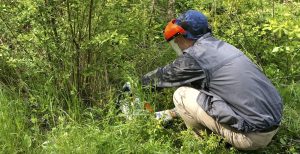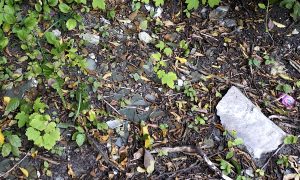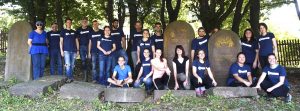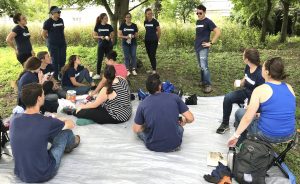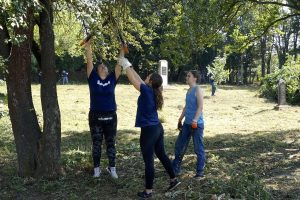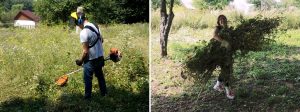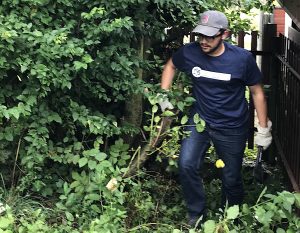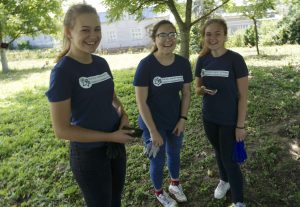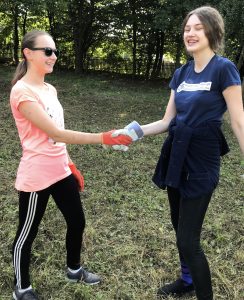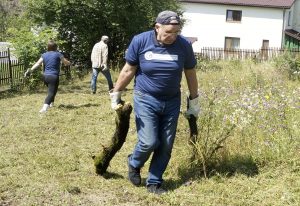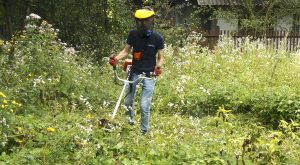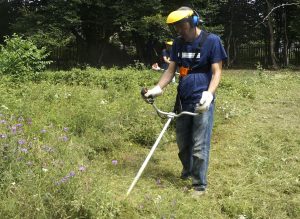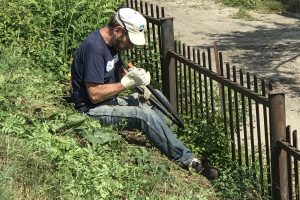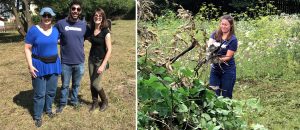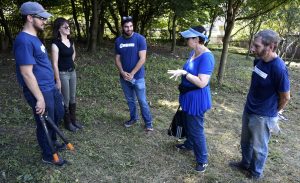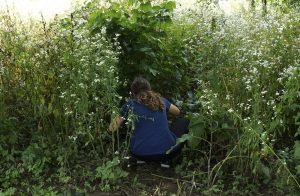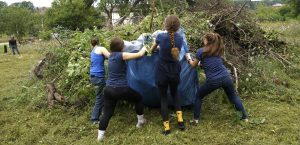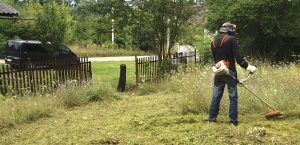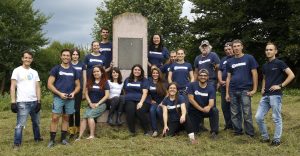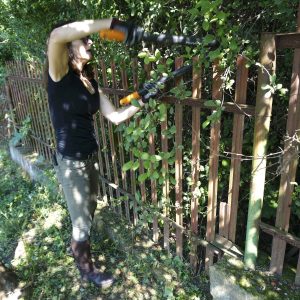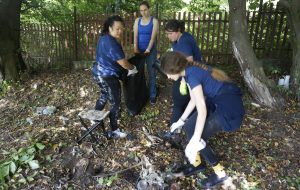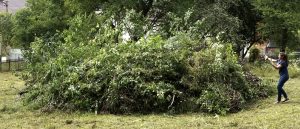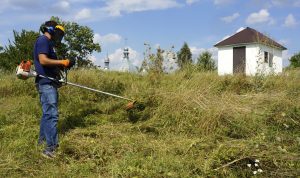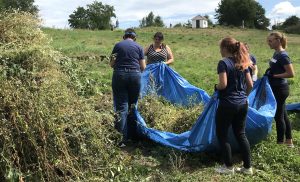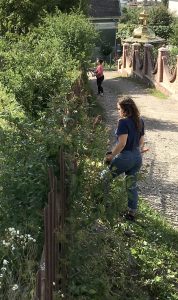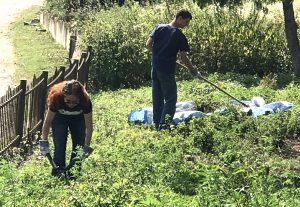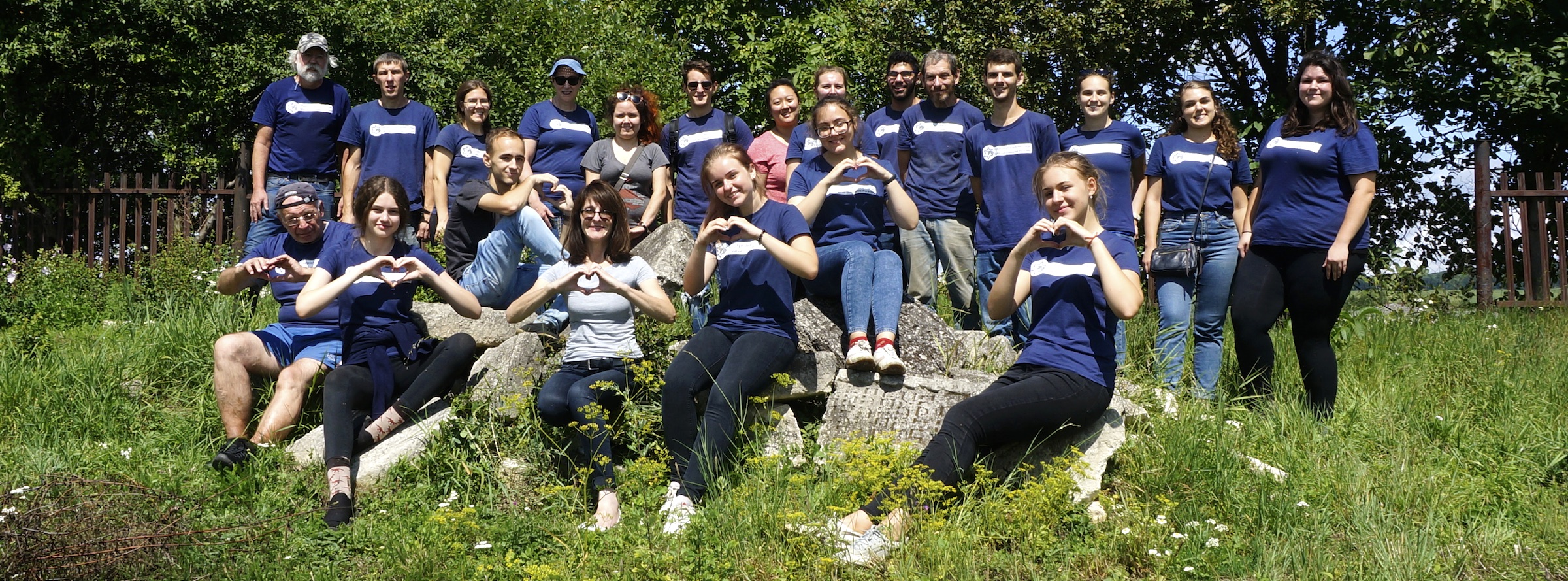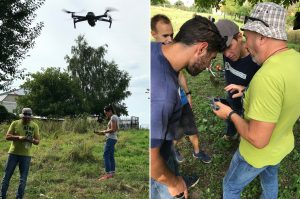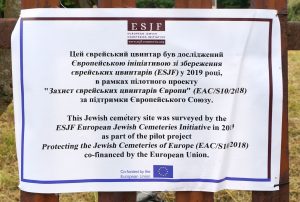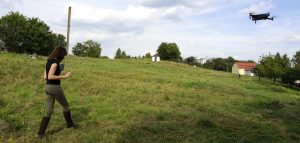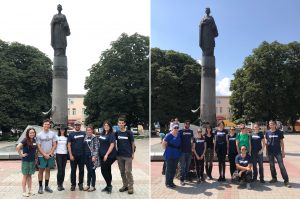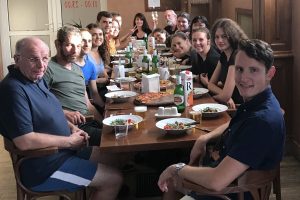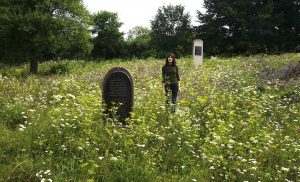
A quick glimpse of our challenge for this event: there’s a cemetery under there, somewhere. Photo © 2019 RJH.
This week Marla and I joined friends and colleagues in another large 3-day volunteer event to clear and clean the Jewish cemeteries in Rohatyn, conducted by our NGO Rohatyn Jewish Heritage. Building on past efforts and powered by the muscle and minds of many wonderful American and Ukrainian volunteers, together we accomplished more than we had hoped at the start, and had a good time in the process. Not only did we clear large areas of tall grass and shrubs, which is important for visual impact in the short term, but the many steadfast hands also progressed a significant amount of important deeper cleaning, clearing, and trimming which will aid our work in Rohatyn for the long term.
Air temperatures were warm throughout the event, with threatening weather forecasts each day, but fortunately the stormy skies never turned into serious rain except at night. We are grateful for the lucky weather, but especially for the volunteer spirit which enabled so much useful progress.
![]() Ця стаття також доступна українською.
Ця стаття також доступна українською.
Our Goals For This Week
Over the past three years of landscape clearing work in Rohatyn, we have learned that the fast-growing grasses and shrubs need clearing at least once during each growing season, and in a heavy rain year as we have experienced this year, even clearing twice is barely enough. We don’t mind the grasses so much, as they die off and partially decay each winter, but we need to clear through the grasses to get at the shrubs and the shoots of small trees which thicken and strengthen every year if we don’t cut them to the ground. Past major cemetery clearing events this year and the prior two years thus included a large measure of woody plant control as well, conditioning the cemeteries some to make them easier to care for.
Earlier this year we worked a day in each of the Jewish cemeteries in May, and three days in the old cemetery in July, on top of an aggressive five-day clearing of dense woody shrubs and small trees in the old cemetery last year and another one-day clearing of the new cemetery as well last year. For this week’s effort, we wanted to focus on the new Jewish cemetery, in particular to:
-
mow all of the tall grass and low shrubs;
- progress cutting trees and heavy shrubs growing through the perimeter fence;
- trim low branches and dead limbs from a portion of the interior trees; and
- dislodge and remove the half-buried glass and metal garbage plus construction debris in one corner of the site.
Depending on our progress in the new cemetery, we also hoped to move to the old cemetery to pick up where we had left off in July, including to:
- mow a portion of the remaining tall grass and low shrubs;
- continue cutting and removing wild shrubs from the fence at the roadside; and
- begin dislodging years-old woody material matted on the ground surface in places.
As always, we also aimed to gain experience in both the ongoing and new aspects of the work, to make our future planning more precise and our future work more effective.
Our Remarkable and Diverse Volunteers
The make-up of this event’s team of volunteers was similar to past large events, with several returning volunteers and many new faces and hands. It was a large group of 25 volunteers, including 17 Americans and 8 Ukrainians, nearly all currently living in Ukraine, and spanning more than five decades in age from the youngest to the oldest. Most volunteers worked all three days, so we had 19 to 21 volunteers every day.
Spirits were high throughout the event, despite some logistical and comfort issues like intermittent water at the hotel where most volunteers slept and the usual array of prickly plants and biting insects during the work. To help Rohatyn Jewish Heritage control our expenses, many volunteers paid their own way to and from Rohatyn for this event (including from far-away Budapest, a distance of over 600km by train and bus). We enjoyed sharing some meals together, exploring Rohatyn a bit on local heritage tours, trading experiences and perspectives about life in Ukraine, America, and elsewhere, and learning a bit about each other, especially the work that each is involved with when not meeting and working in Rohatyn’s Jewish cemeteries.
Peace Corps in Ukraine
Volunteers serving with the Peace Corps in Ukraine formed the core of the team this week as they have several times in the past, and a couple of the PCVs even brought family members to work with them. As always, the individual Peace Corps volunteers (PCVs) are self-managing and self-directing, each exhibiting leadership and problem-solving skills to minimize the management load on Marla and me.
Both Andrés Rodriguez, the PCV serving in Rohatyn, and Kirsten Dyck, a PCV serving in Poltava who first joined us in 2018, were participating for the third time in a large event with us, and together they made a call to the Peace Corps community of volunteers in Ukraine and then organized lodging and communications to give all the PCVs a path to Rohatyn. Andrés then took the helm once the PCVs were in town, and used his local knowledge and contacts to help the first-time visitors adapt and get around Rohatyn, find things they needed, and bridge over any problems which came up. Marla and I again owe these leaders a huge thank-you for carrying so much of the organizational burden, and for freeing us to focus on planning and process related to the tools, the vegetation, and cemetery-specific issues.
Together with Andrés and Kirsten, we had the delightful company of a dozen very bright and energetic PCVs from all over Ukraine, including Ethan Scharf (who had also worked with us in Rohatyn in May) plus Laura Albright, Ashley Coyle, Eric Fein, Rachael Grainger, Daniel Kase, Alli Knepley, Alexander Orta, Hayley Thompson, and Jane Yi. As always with the Peace Corps crew, whenever any number of them took a break from the work and heat together in the shade, the conversation quickly becomes snappy and humorous, and we enjoy learning a bit about their personalities, experiences, and interests. We wish we could have spent more time with them, and we hope to see many of them again, either in Rohatyn or at their own work places.
In addition to their vigor and stamina, a key characteristic of all the PCVs is their openness and readiness to engage with people wherever they are; this is clearly a factor in their volunteering for the Peace Corps in the first place. Countless times during the three days this week, one or more of the PCVs would bring a smile and a kind word to an encounter with a neighbor or a shop clerk, and more than one possible conflict was resolved happily thanks to respectful attitudes and an offer of help. Peace Corps Volunteers serve as very positive ambassadors not only for the United States during their time in Ukraine, but also for Rohatyn Jewish Heritage while they are in town. Our hearts swell with pride to call them friends and allies in civic action.
Ukrainian Colleagues, Students, and Friends
This week we had the largest number ever of Ukrainian volunteers helping in the cemeteries, including several who live in Rohatyn or who have Rohatyn family roots; that was a special treat for us, and it’s a great way for us to make new connections into the local community. It’s also inspiring that these Rohatyners are interested in the multi-cultural history of their town, and in helping to preserve this shared heritage.
Rohatyn’s Youth CSO Lider program, a project organized and promoted by Andrés Rodriguez, was again well represented by three former and current students at the specialized secondary school #1, including Daryna Zavhorodnia and Tania Skorbach who had worked with us in May, and Viktoriya Klishch, who is the niece of our good friend Ihor Klishch – our first supporter in Rohatyn, beginning more than eight years ago.
All of the volunteers were also pleased to welcome Jaryna Vasylyk, a poised girl who lives with her parents in Ivano-Frankivsk but who stayed with her grandmother in Rohatyn for the three days she worked with us, and Polina Paduchak, who lives with her parents in Rohatyn. Jaryna is 14, and Polina only 13, but both had expressed to their parents a desire to help with this project, and we are very happy their parents gave them permission to join us.
This was not the first time we had worked with Ihor Sulzhenko; he lives on vul. Barvinok in Lviv, and like us he helped the Lviv Volunteer Center (LVC) during the flash rescue effort there in 2018 to recover headstones from under the street facing his apartment. During a break from the cemetery work in Rohatyn this week, Ihor made an extended visit to the Rohatyn Opillya local history museum, and he will be able to share his knowledge and experience from this week with groups he guides in the region.
Kalush native Yura Gulivatyy joined us again for his third time working in the Rohatyn Jewish cemeteries; including a PCV-led cemetery clearing event in his home town and an earlier LVC-led work camp in Boryslav, we have now worked alongside Yura five times and we always enjoy his quick smile and easy manner.
Even though he is a native of the Lviv area, probably we should count our dear friend Vasyl Yuzyshyn as a Rohatyn resident now also: this event was already the 15th trip this year he made work with us in Rohatyn, several of those trips for four or five days, including every day of every cemetery work event. And he works hard, as hard as anyone else on our teams, even over many days every year. We depend on Vasyl for a variety of technical and logistical issues which always come up in work events, but more than anything we appreciate his ability to interpret both our words and our good will to cemetery neighbors and other citizens of Rohatyn in a calm and pleasant manner which always represents us well. It’s a pleasure for us to spend time with Vasyl no matter what the activity which brings us together.
Visiting American Friends
It was a great pleasure for us to welcome back to Rohatyn our friend Steve Shore, who first joined us to work in Rohatyn in May. Steve currently lives and works in Hungary, but has family roots in western Ukraine and Moldova, like Marla. Steve’s steady approach to the cemetery work and his unflinching willingness to tackle any task mean that we need only suggest something and Steve will get it done.
Two other volunteers were in Ukraine to visit family members serving this year in the Peace Corps, and it was a special treat for us that they joined their PCV relatives working with us all. Ethan Scharf brought his mother, Janice Gandal Scharf, and Alexander Orta brought his sister, Gabriella Orta. In addition to generously helping with the cutting and hauling, Janice and Gabriella also gave us opportunities to tease Ethan and Alexander, which of course we exploited.
Our Donors and Supporters
As for most of our physical heritage projects in Rohatyn, expenses for this volunteer event were covered by funds gifted from a large number of generous donors around the world. We are thankful for their long-term support of Jewish heritage rehabilitation and preservation in Rohatyn and the region. Support for our projects comes in many forms, from funding to on-site labor to community relations to tools and information, and during this event, even a basket of tomatoes and cucumbers from a neighbor’s garden. Our gratitude is deep for all of this support.
Heads, Hands, and Tools
The most important tools used by the volunteers in the cemeteries are their heads and hands, as always. Of course, as any of them will tell you, their arms and legs and backs get a heavy workout as well. A large part of the work requires on-the-spot assessment and problem solving, and quite a bit of experimentation to find methods which are efficient, effective, and safe. Marla and I are grateful that the volunteers quickly find ways to adapt guidance they receive with their own ideas and trials, resulting in better techniques than we could suggest.
As we learned during our own first clearing efforts in Jewish cemeteries in Poland led by The Matzevah Foundation, the most important task is usually the dragging of vegetation which has been cut by hand or motor tools. It’s important to move the plant materials away from the cutting area both so the materials can be disposed of, but also so that the cutting work can progress unimpeded. During this week’s event the team divided the work themselves so that one or two draggers cleared for one cutter with loppers or a saw, and four to six draggers cleared for one cutter with a motorized brush tool. The clever volunteers quickly figured out how to use plastic tarps to rapidly gather and drag large piles of cut brush, making efficient and quick work of the green waste so the cutter could advance at an optimum pace: heads and hands working together.
Of course the specialized hand and motorized cutting tools are necessary to trim brush and trees quickly without exhausting the volunteers. Our tool set, purchased with targeted donations during the past two years, continues to serve us well, but the tools are showing normal wear and damage from the heavy work. We repair and sharpen what we can after each clearing event like the one this week, but we expect we will need to replace some tools and many tool accessories when winter comes this year.
Despite caution and some safety advice at the start of each volunteer event, inexperience and chance mean that some minor injuries are inevitable. We always prepare for small cuts, scrapes, burns, strains, sprains, and other treatable injuries, and most volunteers bring common antiseptics and bandages with them in anticipation of typical “garden” injuries. We are glad that no volunteers have suffered any serious injuries in any of our cemetery work events, and will work to keep that record intact.
Progress in the New Jewish Cemetery
In May we spent a full day working in the new cemetery with a large group of volunteers including the Lviv Volunteer Center, who had also led or joined work events there on three previous days in 2018 and 2017. Largely thanks to their efforts to “tame” the wild trees and woody shrubs on those occasions, which removed many thorny obstacles, our work this week was focused on routine clearing of tall grass and fast-growing shrubs plus several special tasks.
Continuing the work to remove older shrubs and trees growing through the fences, both for the sake of appearance and the longevity of the fences, several volunteers worked with loppers around the perimeter of the new cemetery. Others used loppers and saws to trim and shape some of the larger trees both at the edges of the cemetery and within its field; we will continue with this aspect of conditioning the cemetery over the next few years. At the request of a neighbor, we also significantly pruned a plum tree at the front left corner which had been overhanging her property and creating a mess from fallen fruit.
Another long-term task got an important start this week: the gradual sifting and removal of old metal and glass garbage, plus hard building waste such as bricks and roofing tiles. Volunteers teamed up or worked individually to make a strong first pass, particularly focused on collecting the dangerous glass fragments and moving them to near the cemetery gate for later disposal.
Work with the brushcutters and loppers revealed approximately a dozen small and medium-sized poisonous heracleum sosnowskyi plants (known locally as borshchivnyk) near the new cemetery’s rear fence, but not before a few of us had accidentally touched the plants; the poison burns the skin like a serious sunburn, but not painfully and eventually the marks fade. We cut and disposed of the plants so we could keep working, after using them to warn all of the volunteers of the risk.
Past conditioning work and a concerted effort by the entire group of volunteers on the first day helped us make great progress very quickly. Some of the group began by shaping the large brush pile at the center of the cemetery to keep it from spreading out and so it can be burned or hauled later. All of the volunteers experimented with the hand tools to solve various problems they encountered with the wild growth, and several learned to use the motorized brushcutters to cut paths through the tall grass and then methodically mow large areas of the cemetery of grass and new shrubs.
All of these different efforts together meant that we met our goals in the new cemetery ahead of expectation, and we finished by noon on the second day: not only was the cemetery visually clear, a lot of less-visible but important conditioning and cleaning was also accomplished. It was a great pleasure to look back on our work and admire the changes made in just a day and a half.
Continuing in the Old Jewish Cemetery
The much larger old Jewish cemetery always requires a gigantic effort, too large for any single volunteer event of several days. Building on the heroic effort of PCVs and The Matzevah Foundation in summer/fall 2018, when most of the wild and thorny shrubs and small trees were cut down, this year we spent a day here in May and another three days in July with large volunteer groups, plus a couple of small multi-day actions by just Marla, Vasyl, and me addressing specific problems such as stumps and wild growth around the recovered headstone fragments. Together the many volunteers on those past days had progressed the cemetery clearing to more than half the area, with important conditioning work well begun.
This week, several volunteers continued trading off working with the brushcutters to complete a full mowing of the tall grass, and using the powered blades to cut down large wild fields with several types of fast-growing reedy plants, small trees, and other nuisance plants which are too hard to cut with string trimmers. We also made some progress chopping through years-old matted tough grass which has built up on the cemetery surface in some places; this will help future clearing by removing an element which always slows our progress.
Blade-cutting the reedier plants produced a huge amount of fallen material, so teams of volunteers joined up to quickly clear the ground, piling the stalks and shoots onto tarps which they then dragged and overturned onto the rising burn piles; this work continued nearly the full time we were in the old cemetery.
Throughout the old cemetery but especially at the south and west fence lines, volunteers used loppers, shears, hand saws and the motorized reciprocating saw to cut down old wild growth and aggressive new growth which had appeared since our earlier events. The determination of this crew easily matched that of the wild plants, and we recovered more clear ground to help future maintenance work.
Other specialized conditioning work was tackled by individual volunteers at several locations in the cemetery, at their own direction. One important task was raking, gathering, and disposing of old woody cuttings which had been left from a prior clearing many years before we started working in the cemeteries; the woody debris was partially decayed and difficult to handle, so we are especially pleased to see those patches cleared and walkable again. In the center of the cemetery, a large cache of empty bottles (probably from a long-ago picnic) was discovered partially buried and under decayed plants, so these were pried loose from the soil and gathered for disposal. Wherever metal debris was discovered as we worked our way through the cemetery, volunteers extracted this also and moved it to the cemetery edge for disposal.
We recognize that one full pass mowing the entire cemetery each year is not enough, especially in wet years like this one; already grass is growing tall again where we first worked in the old cemetery this year, as it had in the new cemetery. But the mowing work also retards fast-growing shrubs which can quickly become difficult to manage with ordinary tools, and the other conditioning work achieved by volunteers this week continues to improve our ability to work efficiently each time we team up here. As tired as the volunteers were at the end of the work days, they have much to be proud of in their progress.
A Very Nice (and Helpful!) Surprise
Late Wednesday afternoon, just as the volunteers had collapsed from exhaustion under a canopy of trees in Rohatyn’s old Jewish cemetery, we were contacted by Hryhoriy Arshynov, chief engineer for ESJF European Jewish Cemeteries Initiative, letting us know that he and his wife were about to arrive at the cemetery to survey it for his organization. Hryhoriy is an old friend, and by chance a distant cousin to Marla through their common family from Mohyliv-Podilskyi in the Vinnytsia Oblast of Ukraine. ESJF is in progress on a massive Jewish cemeteries research and documentation project co-funded by the EU, currently in a pilot stage surveying in five countries including Ukraine. This week Hryhoriy was working in the Ivano-Frankivsk Oblast, including the Rohatyn raion, and he stopped in Rohatyn to survey both Jewish cemeteries.
Although Hryhoriy has also surveyed Rohatyn’s old Jewish cemetery using modern total station theodolite equipment, for the new project ESJF is using drone technology and specialized software to create 3D maps of cemeteries to accurately measure perimeters (for future fencing plans and cost estimates) as well as the surface profile (for other engineering and landscape planning). The new work method is very quick: Hryhoriy surveyed the entire cemetery in less than 20 minutes, and part of that time was spent answering our hundreds of questions!
The timing of ESJF’s surveys in Rohatyn is perfect; we anticipate being able to use the survey data as input to Marla’s Fulbright-funded heritage research project focused on the old Jewish cemetery we were standing in while Hryhoriy worked. We will write more about the measurements and the visualizations after ESJF processes their data and posts the results to their website. In the meantime we encourage everyone to read more about ESJF and their important project at the links above, and on their Facebook page.
Engaging with Rohatyn’s Heritage and Modern Culture
In a running tradition for all of our large volunteer events, Marla and Vasyl took two groups of first-time volunteers in Rohatyn on tours of the town’s former Jewish neighborhoods and the surviving Jewish heritage sites, to tell the history of the past Jewish community as part of the larger story of the town. Beginning in the new Jewish cemetery where we had been working, the tours visited the town square where many Jewish shops once flourished, Valova street where there had been a large number of Jewish religious community buildings (and where two still stand), and the south mass grave, site of the 1942 killing of most of Rohatyn’s Jewish citizens. The tours ended at the old Jewish cemetery, the focal point of our headstone recovery project; discussing the age of the cemetery and the symbolism on the stones gave the volunteers a chance to think about the centuries during which the now-lost Jewish community of Rohatyn had thrived in town.
Andrés, who lives in Rohatyn full time for his Peace Corps work, also gave the volunteers a walking tour of other heritage sites in town, including the UNESCO-listed historic wooden Holy Spirit church, and the nearby WWI Austrian soldier’s cemetery. Rohatyn has several historic wooden churches, plus cemeteries of four different faiths linked to the town’s multicultural past and its place in a territory which has been contested many times over the past centuries.
Another running tradition (and an unspoken goal of the event) was a shared pizza dinner the first night, giving us a chance to relax together and to continue conversations which are sometimes hard to advance while working in the cemeteries. Thanks to advance planning by Andrés and Yura, the hot food was waiting for us when we arrived and the drinks came shortly after. Whether veterans of these events or first-time volunteers, we always learn fun facts about our colleagues when they have a chance to wind down.
Looking Forward
Even as we begin to clean, repair, and sharpen the tools for the next volunteer event, Marla and I realize that vegetation will continue to grow wild in the Jewish cemeteries, as it does in all of the cemeteries in Rohatyn. We anticipate doing some further tidying work in the old cemetery this year, especially to trim grass and shrubs which have already returned to obscure some of the recovered headstone fragments. Likewise we will continue our vigilance about cutting the poisonous heracleum, until the growing/flowering season is over this year.
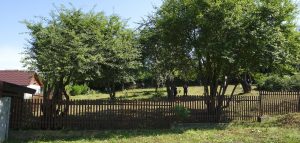
The view into the new Jewish cemetery is improved after tree work at the front fence. Photo © 2019 RJH.
Otherwise our planning will mostly focus now on work we can do best in the cool and cold months, when the grass is dead and shrubs are dormant: stump-cutting in both cemeteries, as part of our long-term effort to condition the spaces to make them easier to maintain, and further tree care in both cemeteries. Probably we will progress these tasks on our own (and with Vasyl), as we do not have enough motor saws to keep more than a few of us busy in this work. We still have some other long-term problems to solve, e.g. the large number of anthills, and subsurface hard debris and garbage in both cemeteries.
Thus the most important long-term planning for the cemeteries is tied to Marla’s Fulbright project; a key outcome of that research, we hope, is a carefully-considered plan to rehabilitate the cemetery in a way which reduces the necessary annual maintenance, presents the recovered headstones for both education and memory, and helps to reintegrate the cemetery as a memorial space of the living town.

